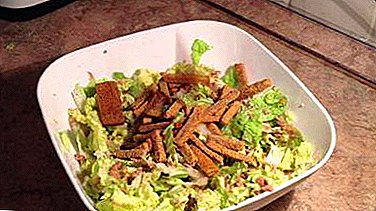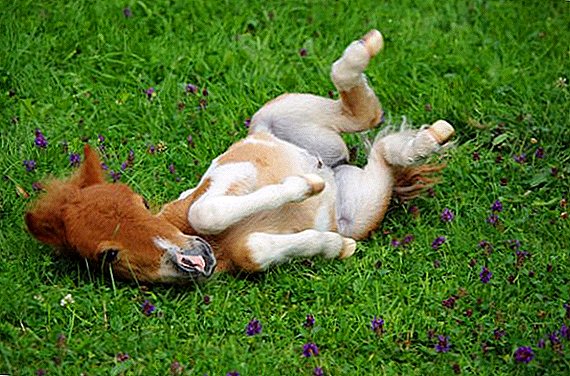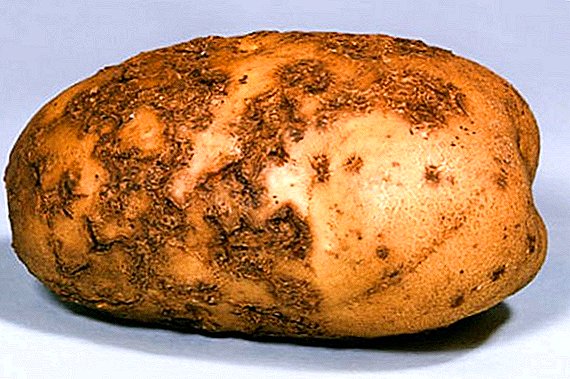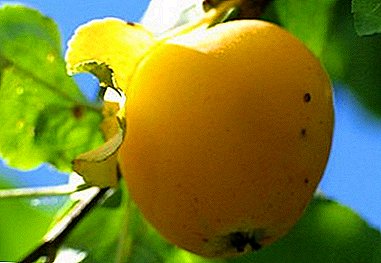 Today, poultry farmers have an excellent opportunity to choose from a huge number of breeds of chickens. Particularly popular juristic vociferous chickens.
Today, poultry farmers have an excellent opportunity to choose from a huge number of breeds of chickens. Particularly popular juristic vociferous chickens.
In our article we will give a description of this breed, tell you about the features of feeding and maintenance.
History reference
Yurlov chickens do not belong to those breeds that were bred specifically for weight gain or high egg production. The result of the breeding of this bird is the people's love for rooster crows.
Important! During the period of seasonal molting, which lasts about 4 months, it is necessary to include in the diet as much as possible products rich in minerals and vitamins.
 A distinctive feature of the breed is low, loud and very prolonged singing.
A distinctive feature of the breed is low, loud and very prolonged singing.
As evidenced by the writing of the beginning of the 20th century, some representatives struck with their singing: their voice was heard over the district for quite a long time, and by verbal account reached 22.
Video: Singing Yurlov Roosters
Surely it is not known exactly how this breed appeared. However, according to some opinions, it arose as a result of the interbreeding of the fighting and local breed - most likely, bram and kokhinhin.
In addition, a parallel was laid between the breed of Yurlov chickens and several villages located in the Kursk and Oryol gubernias in the late 19th century. 
Characteristics and features
This breed has a special interesting appearance and its own characteristic features. We suggest to get acquainted with them.
Appearance
Singers are owners of an elongated, having a rectangular shape and horizontal setting of the body, which only confirms their belonging to wrestling family. The location of the neck and tail is at right angles to the body. The breast has a rounded shape, fairly well developed. The back also has a rounded shape. The wings have an average length, most often fit snugly to the body.
Both the cockerels and the hens, due to the impressive length of the neck and legs, look quite handsome and high. Paws of yellow, orange or brown color. Male individuals are taxed by more developed shins and hips.  The head is large and wide, has a red color, in tone with the earrings and scallop. Earrings are not too large, rounded. The comb has a nut-like, rose-like or leaf-shaped form. The main facial accent is clear eyebrows and the presence of a powerful, wide but short beak. Most often it is yellow-black or brown. Feathers may have a different color. Most often they are light, silver, brown or black.
The head is large and wide, has a red color, in tone with the earrings and scallop. Earrings are not too large, rounded. The comb has a nut-like, rose-like or leaf-shaped form. The main facial accent is clear eyebrows and the presence of a powerful, wide but short beak. Most often it is yellow-black or brown. Feathers may have a different color. Most often they are light, silver, brown or black.
Familiarize yourself with the representatives of the breeds of chicken, egg, meat, meat, egg, decorative, fighting directions.
Character
Those who wish to breed this bird need to be prepared for what they have very complex. They are aggressive, hot-tempered, impulsive. No cockerels, no chickens will accept the fact that aliens will appear on their territory.
In most cases, physical force is used to resolve all conflicts. For this reason, it is worthwhile to take seriously the issue of the distribution of individuals and families, so that in the future there will be no injuries and problems on the poultry yard.
Another feature is that screamers cannot restrain themselves and not sing. You can get rid of the alarm clock, as the voice of the bird will be heard within a radius of 10-20 meters. 
Hatching instinct
There are some subtleties associated with the breeding of this breed. Chickens have an incubation instinct, however, in some females it may not manifest at 100%.
In order for breeding to be effective, it is worth adhering the following recommendations:
- it is very important to make families correctly. 12-20 chickens need 1 rooster;
- select birds for breeding regardless of their phenotype - the offspring with the same color, you will not succeed. About 50% of chickens are able to inherit the parent color, the second half will differ in the color of feathers;
- when choosing cockerels, preference should be given to those individuals that are able to sing longer and have a beautiful timbre of voice. In order to preserve singing qualities, it is worth choosing birds with low clucking timbre among chickens;
- the ideal representative of the parent flock is the rooster, who began to hum his livers after attaining one year old;
- Because of the large weight of the parents, often after the “honeymoon” chickens can be detected in chickens, injuries and selected feathers. To avoid this, it is recommended to wear special clothes on them - waistcoats.

Weight indicators
Yurlovsky hens - rather large birds. The mass of a mature rooster is 6-6.5 kg, and chicken - 4 kg.
Did you know? Chickens are carried only in the presence of light. Even if the deadline has already reached the laying of eggs, the bird will wait until the day comes or the lights come on.
Puberty and annual egg production
The genetic features of chickens are that their ripening can not occur before 8-9 months. This applies to almost all late ripening wrestlers. Due to the large weight and complex process of muscle formation, puberty occurs more slowly than other breeds.
Find out what to do if chickens do not carry well, carry small eggs, peck eggs, as well as good eggs and eggshell.
Egg production is quite acceptable. In this case, special attention should be paid not to the number of eggs, but to their average weight, which is 70-75 g. For a year, the hen is able to produce 130-180 eggs. 
Diet
In order to ensure greater egg production and good bird survival, it is necessary to take care of its nutrition. Consider which diet is acceptable for young and which for adult birds.
Young
- The first time to feed the young growth is after the fluff dries and they are transferred to the dwelling.
- The first product that chicks have to eat is a boiled egg. And only on the third day you can give kids cereal, maggots, cottage cheese and ground beef.
- The period from 2 to 6 months is special, since at this time there is an intensive growth of chicks. It is very important to provide them with enhanced nutrition, and the daily intake of minerals into their bodies. The main food should be feed.
- Greens and vegetables should be present in the diet of babies, ensuring the normal functioning of the gastrointestinal tract.
We advise you to read about the correct feeding of chickens in the first days of life.
Adult chickens
For breeding chickens for business purposes, this breed is extremely disadvantageous, as the birds need a lot of food, which makes them unprofitable.  Consider what should go into ration of adults in summer and winter.
Consider what should go into ration of adults in summer and winter.
- In the diet should be a lot of wheat, oats, corn, peas and soybeans. Every day, a rooster is given 150 g, and a chicken - 100-120 g.
- In winter, a couple of times a week should be added to the menu of grass meal. It is also important to give the bird greens and vegetables. In the winter season, one individual should eat 100 g of vegetables per day.
- Every day the bird should eat foods that contain proteins. They are in worms and maggots, fish, meat, cottage cheese.
- During laying it is important that chalk and shells are present in the diet. In other periods, they should also be on the menu, but in smaller quantities.
- In the summer, it is worth giving the bird a lot of fresh greenery.
- In the summer it is important to ensure that the bird drank a lot of water, since as a result of dehydration it will become lethargic and weak.
Learn more about the nutrition of laying hens: cooking at home, the daily feed rate, vitamins for egg production.
Conditions of detention
In addition to proper nutrition, it is worth providing chickens proper maintenance. 
Requirements for the room
The optimum temperature for the content of birds is + 12 ° C. It is important to ensure the flow of daylight for a period of 13-14 hours. It is important to ensure that there is no draft, but air circulation must be present. In size, you need to select a room in which 0.5 cu. meters
Important! Do not let the litter get wet - if it is always in a wet state, it will contribute to the development of necrobacteriosis, coccidiosis and other poultry diseases.
As a coating, you can use a deep non-replaceable bedding, for the manufacture of which you will need peat, straw or sawdust. They are good in that they perfectly absorb any moisture. Litter need to be twice a year. Cleanliness should be maintained in the house, and a lime layer should be laid on the floor, which can prevent the development of fungi and harmful microorganisms.
Learn more about home improvement for chickens: criteria for selecting and buying a chicken coop, self-made and home improvement (making roost and nests).
Walking yard
Representatives of the Yurlovskaya breed love freedom, and in order for them to feel comfortable, it is necessary to build a walking yard for them, which is enclosed by a fence so that the chickens cannot get out of it. Thanks to this "additional" territory, birds will be able to go for a walk at any time. 
Feeders and drinkers
It is important to build feeders and drinkers for the birds. For each representative should be allocated 10 cm for food and 2.5 cm for drinking. Feeders should be designed in such a way that they cannot feed or scatter feed. It is necessary to fill it in one third. Mineral supplements (shell, chalk, limestone, gravel) should be placed in the hotel feeder.
The drinking bowl can be of different types.: vacuum, nipple, groove. It is necessary to try to make sure that the water does not splash onto the floor and the drinking bowl does not become clogged with droppings.
How to endure winter cold
This breed is not afraid of cold and cold, they can spend the winter in the house, even without additional heating.  However, according to farmers, laying hens are more productive in a heated room, so they try to maintain a temperature indicator of + 10-12 ° C.
However, according to farmers, laying hens are more productive in a heated room, so they try to maintain a temperature indicator of + 10-12 ° C.
Read also about the maintenance of chickens in the winter season, the construction of a winter chicken coop for 20 chickens, ways to heat the chicken coop.
Pros and cons of breed
The main advantages of the breed include:
- high egg and meat productivity;
- the presence of good taste of meat and eggs;
- the presence of fairly large eggs;
- high rate of fertility, hatchability and survival of offspring;
- good immunity to many diseases.
Among the shortcomings are the following:
- the presence of aggressiveness in roosters;
- too late productivity;
- the need for large maintenance areas;
- low meat productivity.
Did you know? Chickens do not care whose eggs they hatch, their own or others, they hatch everything indiscriminately.
Video: chickens breed yurlovskaya vociferous
Yurlovskaya breed of chickens: reviews

Yurlov vocal breed is not quite suitable for mass rearing, but if you want to get large eggs and like to listen to long singing in the morning - these birds are perfect for you. However, it is worth remembering that high productivity can be achieved only with proper feeding and keeping of individuals.












